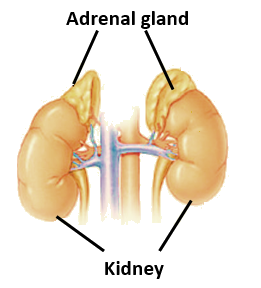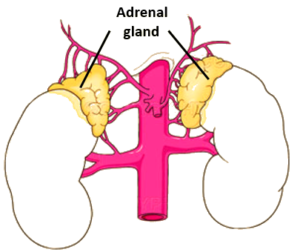Introduction
The human body contains a variety of endocrine glands that secrete various hormones, each with a unique function. To maintain the body’s normal physiological state, each hormone must be present in sufficient amounts. Any variation in an endocrine gland’s hormone release obviously affects the body’s natural state of health. One adrenal gland is located above each kidney in a pair. Blood pressure, stress reactions, and body metabolism are all influenced by the adrenal hormones. Adrenal insufficiency is the term used to explain when the body produces less of these hormones than is necessary.
What is the Adrenal gland?
Adrenal glands are the triangular-shaped, small-sized glands lying on the top of each kidney. For this reason, they are also called the suprarenal glands. A cross-section of the adrenal gland shows two layers where the outer layer is called the cortex, and the inner layer is called the medulla.
The largest portion of the gland is the outer adrenal cortex. Zones glomerulosa, fasciculata, and reticularis make up its structure. At the center of the triangle, gland is the inner adrenal medulla. The cortex and medulla of the gland are shielded by an exterior capsule to maintain their endocrine activity.

For more help, you can Refer to Lesson 10 – Adolsence in life in Science Class 8 Lesson. Checkout the video for a better understanding
Hormones secreted
The cortex and medulla produce separate endocrine secretions. Different hormones with various roles are secreted by the adrenal cortex’s various zones.
Adrenal cortical hormones: Three distinct hormones are secreted by the adrenal cortex from its three layers.
- Glucocorticoids: The zona fasciculata layer of the adrenal cortex secretes the main glucocorticoid hormone, cortisol. It is the body’s own natural steroid and is released in response to stress. The hormone cortisol regulates the body’s blood pressure, metabolism, and sleep-wake cycle. The body can better handle stress and emergency situations thanks to it as well. By encouraging its creation, cortisol also keeps the body’s levels of glucose stable.
- Mineralocorticoids: The main mineralocorticoid released by the zona glomerulosa is aldosterone. Aldosterone’s primary job is to keep the body’s electrolyte and water balance in check. It works by telling the kidneys to remove potassium from the body and reabsorb sodium into the bloodstream.
- Adrenal Androgens: The androgens secreted by the zona reticularis include testosterone and DHEA (Dehydroepiandrosterone), which are known as adrenal androgens. Male hormones called adrenal androgens are weak. Although females also release testosterone, the majority of it is a precursor that is transformed into estrogens in the ovaries.
Hormones of the adrenal medulla:
- Catecholamines are a broad term for adrenal medullary hormones. They contribute to the physiological effects of stress. The catecholamines are dopamine, norepinephrine (noradrenaline), and epinephrine (adrenaline).
- The stress-related blood pressure, heart rate, respiration, pupil dilation, and pale discoloration are brought on by the hormones adrenaline and norepinephrine. They are known as the flight and fear hormones for this reason.
Adrenocorticotropic hormone (ACTH), which is secreted by the pituitary gland, regulates the release of androgens and glucocorticoids from the adrenal glands. The hypothalamic secretions corticotropin-releasing hormone (CRH), antidiuretic hormone (ADH), and vasopressin regulate the pituitary’s release of ACTH.
Diseases related to insufficiency
The release of glucocorticoids, mineralocorticoids, and androgens can be impaired by damage to the cortical tissue or any malfunction. The condition is known as adrenal insufficiency. There could be a number of causes for this condition.
- Primary adrenal insufficiency:
- It is also known as autoimmune adrenalitis or Addison’s disease. It happens as a result of disease in the cortical region of the adrenal glands.
- It is characterised by diminished adrenal gland function.
- It develops as a result of autoantibodies targeting the adrenocortical enzymes causing the self-destruction of adrenal tissues.
- Other reasons include malignancies, infections with syphilis or tuberculosis, and adrenal haemorrhage.
- Secondary adrenal insufficiency:
- It happens when the pituitary gland does not secrete enough ACTH to support adequate levels of adrenal hormone output.
- Traumatic brain damage and panhypopituitarism cause this disease.
- Tertiary adrenal insufficiency:
- This results from the hypothalamus’s insufficient secretion of corticotropin-releasing hormone (CRH).
- Patients who undergo particular operations to treat Cushing’s syndrome have also reported experiencing it.
Compared to the other two kinds, primary adrenal insufficiency is more common. The medulla is largely unaffected, whereas the cortex is impaired. As a result, the production of aldosterone and cortisol decreases in those with this illness.
Symptoms:
- Fatigue and weakness
- Joint pains
- Hyperpigmentation
- Weight loss
- Salt cravings
- Low blood pressure and hypotension
- Abdominal pain
- Decreased body hair in women
- Decreased libido
- Low blood glucose
The participants are examined for preexisting hyponatremia, hyperkalemia, and hypoglycemia as soon as symptoms appear. Adrenal insufficiency is established with blood tests, including those for ACTH, cortisol, renin, and aldosterone, and is then successfully treated. Hormone replacement therapy is a significant component of treatment.
Summary
Adrenal glands are the triangular-shaped, small-sized glands lying on the top of each kidney. The largest portion of the gland is the outer adrenal cortex. Catecholamines are a broad term for adrenal medullary hormones. They contribute to the physiological effects of stress. Primary adrenal insufficiency is also known as autoimmune adrenalitis or Addison’s disease. It happens as a result of disease in the cortical region of the adrenal glands.
FAQ’s
- Define autoantibodies?
Ans. Autoantibodies are proteins synthesised by one’s own immune system owing to the destruction of one’s self-tissues and organs. Due to autoantibodies produced by Addison’s disease, the adrenal cortex is destroyed, leading to impaired hormonal secretion and dysfunction.
- Is adrenal insufficiency potentially fatal?
Ans. With the right care and safety measures, someone with adrenal insufficiency can lead a normal life. Untreated conditions including high potassium, low sodium, and low sugar levels in the body linked to low blood pressure can have fatal consequences.
- What do you mean by steroid hormones?
Ans. Steroid hormones are all hormones that are biochemically steroid-like. Since lipids constitute the foundation of these macromolecules, they are called fat-soluble hormones and naturally come from cholesterol. The two groups of steroid hormones are corticosteroids and sex steroids, which are both secreted by the adrenal cortex and the gonads, respectively.
- Write a note on catecholamines?
Ans. Catecholamines are natural amines with neurotransmitter properties. Chemically, they are benzene rings with hydroxyl amine groups. Stress manifestation functions are carried out by the catecholamines the adrenal medulla secretes.
- What is the function of hypothalamus?
Ans. The brain region with endocrine functions is called the hypothalamus. It secretes hormones that regulate the pituitary’s release of a variety of hormones that regulate a range of bodily functions.
